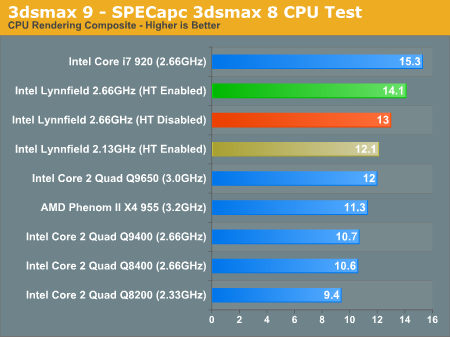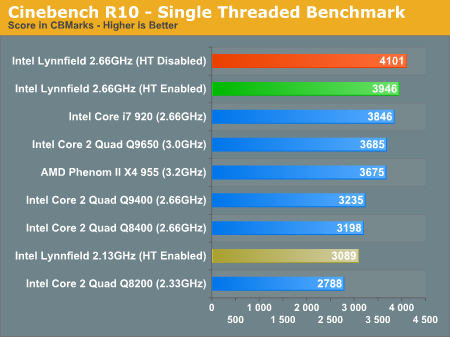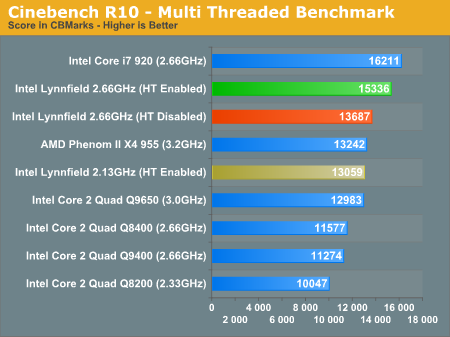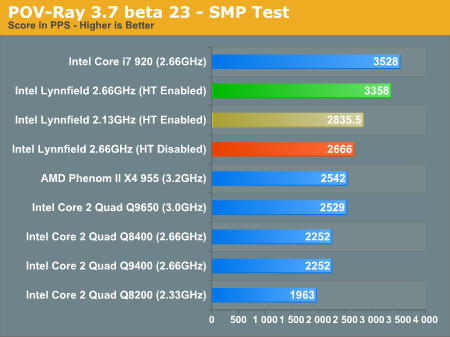The Lynnfield Preview: Rumblings of Revenge
by Anand Lal Shimpi on May 29, 2009 1:00 PM EST- Posted in
- CPUs
3dsmax 9 - SPECapc 3dsmax CPU Rendering Test
Today's desktop processors are more than fast enough to do professional level 3D rendering at home. To look at performance under 3dsmax we ran the SPECapc 3dsmax 8 benchmark (only the CPU rendering tests) under 3dsmax 9 SP1. The results reported are the rendering composite scores:

There are three key takeaway points here.
1) Hyper Threading allows the i7-920 to outperform the entry level Lynnfield by nearly 18%.
2) With HT disabled, the $196 Lynnfield is faster than the $316 Core 2 Quad Q9650. It's a true replacement for Penryn in the lineup.
3) Intel could release an even slower Lynnfield and, by enabling HT, offer a chip faster than all other Penryn and Phenom II based processors in the market.
Cinebench R10
Created by the Cinema 4D folks we have Cinebench, a popular 3D rendering benchmark that gives us both single and multi-threaded 3D rendering results.

The single threaded Cinebench test shows us just how powerful the Nehalem core is. Remember, we're looking at single-core performance here.
Without an aggressive turbo mode, the 2.66GHz Lynnfield sample is faster than a 3.0GHz Penryn. Even at 2.13GHz Lynnfield is able to perform like a 2.5GHz Penryn. This is a very flexible core.
These results also give you an indication of exactly how strong the dual-core Nehalem derivatives will be in notebooks late this year and into 2010.

Crank up the thread count and feel the frustration brew. The entry level Lynnfield won't have Hyper Threading enabled, and thus it'll only outperform the Phenom II 955 by 3.4%. Had Intel enabled the HT switch, Lynnfield would not only be 16% faster than AMD's best but it would also be only 5% slower than the i7-920.
POV-Ray 3.73 beta 23 Ray Tracing Performance
POV-Ray is a popular, open-source raytracing application that also doubles as a great tool to measure CPU floating point performance.
I ran the SMP benchmark in beta 23 of POV-Ray 3.73. The numbers reported are the final score in pixels per second.

We see a similar story in POV-Ray.










95 Comments
View All Comments
Jabbernyx - Monday, June 1, 2009 - link
You're forgetting the $10 off promo code and 5% Live cashback ;)Randomblame - Friday, May 29, 2009 - link
Anyone else irritated that when this launches intel will have 5 sockets going?Shall we count em?
lga 775 core 2
lga 1366 i7
lga 1160 lynfield
lga 771 xeon penryn
lga 611 itanium
Did I miss any?
Anonymous Freak - Sunday, May 31, 2009 - link
If you're going to include Itanium; you might as well include the mobile sockets as well.Last October, Intel had one desktop, three server, and two mobile sockets:
LGA775 on the desktop was it.
LGA771 for dual Xeon, PGA-604 for quad-plus Xeon. (And LGA775 for single-socket servers, where the processors were just Core 2 series processors slapped with a "Xeon" name on them, so I'm keeping that with 'desktop'.) PAC-611 is Itanium.
Socket M is the slightly older mobile socket, Socket P is the newer. One could say that Socket M was already dead in October.
Early next year, we will have three desktop, two server, and two mobile sockets.
LGA 775 will be the low-end Core 2 socket, LGA 1366 for i7, and LGA 1156 for Lynnfield. Lynnfield should overtake Core 2 very quickly, especially after the integrated-graphics chips come out, and drop to two desktop sockets, though.
LGA 1366 doubles as the single and dual server socket; and the new "Nehalem EX" will in all likelihood have a new socket shared with the new Itanium (from reasonable guesses, anyway.)
Mobile will have just Socket P until the mobile Nehalems launch, when a new mobile Nehalem socket will be out.
Sorry, but LGA 771 is already dead. Its processors are completely obsolete at this point, by Nehalem-EP. And PGA-604 (which you missed,) as well as PAC-611, will be obsoleted by the Nehalem-EX socket. (Again, just guessing. The entire point of QPI was to make Xeon and Itanium share resources, so I would imagine they would use the same socket. Especially with Xeons now at higher power draw than even the highest draw Itanium; there is no reason for Itanium's goofy socket-with-power-pod arrangement any more.
Drazick - Friday, May 29, 2009 - link
Though the system looks good.I really liked the one chip Idea (Chipset).
I hope Intel eventually let nVidia develop chipsets for this platform.
Why don't you think the regular PCIE X16 lane in this system is enough for GPGPU? It might not be the best but for Encoding some movies and Accelerating Matlab it should be enough, no?
Anand Lal Shimpi - Saturday, May 30, 2009 - link
I didn't mean to imply that 16 PCIe 2.0 lanes aren't enough for GPGPU. But if you're doing a *lot* of compute over the PCIe bus, perhaps over multiple very high end GPUs, then you'll probably want QPI. This is more of a HPC or head-in-the-clouds-desktop scenario though.It should be more than enough for GPU based video encode or math.
Take care,
Anand
ssj4Gogeta - Friday, May 29, 2009 - link
Even if Intel allows Nvidia, they can't make integrated graphics for i5 because the chip is connected to the chipset via 2 GB/s DMI, which will bottleneck it.Doormat - Friday, May 29, 2009 - link
Until the price of 4GB DDR3 sticks come down (and I could put 16GB of RAM on the board), I think the i7 is where its at. At least with i7, I can go with 12GB now and then upgrade to 24GB later (12GB I need, 24GB I don't know...).A5 - Friday, May 29, 2009 - link
If you NEED 12GB, then Lynnfield isn't going to be for you. Intel would much rather you use Xeons for that kind of workload anyway :Pltcommanderdata - Friday, May 29, 2009 - link
So with mainstream Nehalems not having any QPI links and high-end Nehalems with QPI not needing them, are third-party IGPs dead? It seems that even if nVidia can win their legal issues with Intel, the technical challenges of being limited to DMI seem to make the Intel chipset business unprofitable. Higher priced chipsets with IGPs would be bandwidth limited over DMI and just making southbridges doesn't seem very glamourous or profitable.Anand Lal Shimpi - Saturday, May 30, 2009 - link
NVIDIA claims to have DMI based IGPs in development for LGA-1156 platforms. We'll see how good they are and if they do end up coming to market despite the legal issues.In the long run I don't expect the 3rd party chipset business to survive on either platform (AMD or Intel). Unless either company is horribly deficient at some basic platform need I'd expect desktop and mobile AMD CPUs to use AMD chipsets and for desktop and mobile Intel CPUs to use Intel chipsets. It may take a couple of years to get there but I think the end result is inevitable.
I believe that's why we're seeing such a strong push from NVIDIA lately with things like Ion. Attempting to stay put when we know what the tide is about to do is a difficult task.
Take care,
Anand